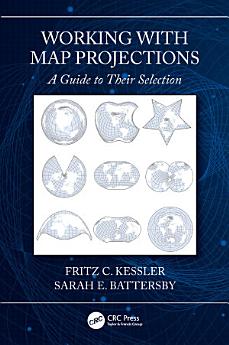Working with Map Projections: A Guide to their Selection
About this ebook
This book also explains how the map projection will impact the map’s ability to fulfill its purpose, uses real-world data sets as the basis for the selection of an appropriate map projection, and provides illustrations of an appropriately and inappropriately selected map projection for a given data set. The authors take a novel approach to discussing map projections by avoiding an extensive inventory of mathematical formulae and using only the mathematics of map projections that matter for many mapping tasks. They also present information that is directly applicable to the process of selecting map projections and not tied to a specific software package.
Written by two leading experts, this book is an invaluable resource for anyone studying or working with geospatial data, from students to experienced professionals, and will help readers successfully weigh the pros and cons of choosing one projection over another to suit a map’s intended purpose.
About the author
Fritz Kessler, PhD, is a senior research associate and an associate professor at Penn State University. His primary responsibilities are teaching in the resident and online world campus environments. Some of the courses he has taught include map projections, datums, and coordinate systems, cartography, surveying, GIS, spatial statistics, and research methods. Dr. Kessler's research interests include map projections, geographic visualization, and cognitive cartography. His recent publications include a co-authored book, Thematic Cartography and GeoVisualization; an article, “Volunteered Geographic Information: A Bicycling Enthusiast Perspective” in Cartography and Geographic Information Science; two co-authored papers, “Analysis of Thematic Maps Published in Two Geographical Journals in the Twentieth Century” in Annals of the Association of American Geographers and “Cues for Interpreting Distortion in Map Projections” in Journal of Geography; a co-authored book chapter “Thematic Mapping” in The History of Cartography Project, Volume 6: Cartography in the Twentieth Century; a chapter contribution “Symbolizing America” to Mapping American: Exploring the Continent; and an authored entry “Projections” in the International Encyclopedia of Human Geography. Dr. Kessler earned a PhD in geography in 1999 at the University of Kansas, an MS at Penn State, and a BS at Ohio University. He is a member of the International Cartographic Association Commission on Map Projections, vice president of the North American Cartographic and Information Society, and a board member of the Cartography and Geographic Information Society. He was a former editor in chief of Cartographic Perspectives.
Sarah E. Battersby, PhD, is a senior research scientist at Tableau Software. Her primary area of focus is cartography with an emphasis on cognition. Her work emphasizes how we can help people visualize and use spatial information more effectively. Her research has covered a variety of areas, including perception in dynamic map displays, geospatial technologies and spatial thinking abilities, and the impact of the map projection on spatial cognition. Sarah earned a PhD in geography in 2006 at the University of California at Santa Barbara. She is a member of the International Cartographic Association Commission on Map Projections and a past president (2015-2016) of the Cartography and Geographic Information Society, a society composed of educators, researchers, and practitioners involved in the design, creation, use, and dissemination of geographic information. Dr. Battersby is also a member of the National Geospatial Advisory Committee, a Federal Advisory Committee sponsored by the Department of the Interior under the Federal Advisory Committee Act.





